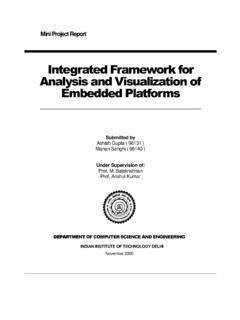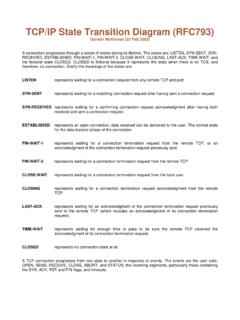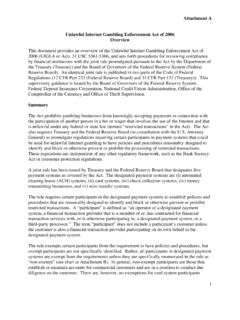Transcription of MDA: A Formal Approach to Game Design and Game Research
1 MDA: A Formal Approach to Game Design and Game Research Robin Hunicke, Marc LeBlanc, Robert Zubek Abstract In this paper we present the MDA framework (standing for Mechanics, Dynamics, and Aesthetics), developed and taught as part of the Game Design and Tuning Workshop at the Game Developers Conference, San Jose 2001-2004. MDA is a Formal Approach to understanding games one which attempts to bridge the gap between game Design and development, game criticism, and technical game Research . We believe this methodology will clarify and strengthen the iterative processes of developers, scholars and researchers alike, making it easier for all parties to decompose, study and Design a broad class of game designs and game artifacts.
2 Introduction All artifacts are created within some Design methodology. Whether building a physical prototype, architecting a software interface, constructing an argument or implementing a series of controlled experiments Design methodologies guide the creative thought process and help ensure quality work. Specifically, iterative, qualitative and quantitative analyses support the designer in two important ways. They help her analyze the end result to refine implementation, and analyze the implementation to refine the result. By approaching the task from both perspectives, she can consider a wide range of possibilities and interdependencies.
3 This is especially important when working with computer and video games, where the interaction between coded subsystems creates complex, dynamic (and often unpredictable) behavior. Designers and researchers must consider interdependencies carefully before implementing changes, and scholars must recognize them before drawing conclusions about the nature of the experience generated. In this paper we present the MDA framework (standing for Mechanics, Dynamics, and Aesthetics), developed and taught as part of the Game Design and Tuning Workshop at the Game Developers Conference, San Jose 2001-2004 [LeBlanc, 2004a].
4 MDA is a Formal Approach to understanding games one which attempts to bridge the gap between game Design and development, game criticism, and technical game Research . We believe this methodology will clarify and strengthen the iterative processes of developers, scholars and researchers alike, making it easier for all parties to decompose, study and Design a broad class of game designs and game artifacts. Towards a Comprehensive Framework Game Design and authorship happen at many levels, and the fields of games Research and development involve people from diverse creative and scholarly backgrounds.
5 While it s often necessary to focus on one area, everyone, regardless of discipline, will at some point need to consider issues outside that area: base mechanisms of game systems, the overarching Design goals, or the desired experiential results of gameplay. AI coders and researchers are no exception. Seemingly inconsequential decisions about data, representation, algorithms, tools, vocabulary and methodology will trickle upward, shaping the final gameplay. Similarly, all desired user experience must bottom out, somewhere, in code. As games continue to generate increasingly complex agent, object and system behavior, AI and game Design merge.
6 Systematic coherence comes when conflicting constraints are satisfied, and each of the game s parts can relate to each other as a whole. Decomposing, understanding and creating this coherence requires travel between all levels of abstraction fluent motion from systems and code, to content and play experience, and back. We propose the MDA framework as a tool to help designers, researchers and scholars perform this translation. MDA Games are created by designers/teams of developers, and consumed by players. They are purchased, used and eventually cast away like most other consumable goods.
7 Game Creates Consumes DesignerPlayerThe production and consumption of game artifacts. The difference between games and other entertainment products (such as books, music, movies and plays) is that their consumption is relatively unpredictable. The string of events that occur during gameplay and the outcome of those events are unknown at the time the product is finished. The MDA framework formalizes the consumption of games by breaking them into their distinct components: and establishing their Design counterparts: Mechanics describes the particular components of the game, at the level of data representation and algorithms.
8 Dynamics describes the run-time behavior of the mechanics acting on player inputs and each others outputs over time. Aesthetics describes the desirable emotional responses evoked in the player, when she interacts with the game system. Fundamental to this framework is the idea that games are more like artifacts than media. By this we mean that the content of a game is its behavior not the media that streams out of it towards the player. Thinking about games as designed artifacts helps frame them as systems that build behavior via interaction.
9 It supports clearer Design choices and analysis at all levels of study and development. MDA in Detail MDA as Lens Each component of the MDA framework can be thought of as a lens or a view of the game separate, but causally linked. [LeBlanc, 2004b]. From the designer s perspective, the mechanics give rise to dynamic system behavior, which in turn leads to particular aesthetic experiences. From the player s perspective, aesthetics set the tone, which is born out in observable dynamics and eventually, operable mechanics. When working with games, it is helpful to consider both the designer and player perspectives.
10 It helps us observe how even small changes in one layer can cascade into others. In addition, thinking about the player encourages experience-driven (as opposed to feature-driven) Design . As such, we begin our investigation with a discussion of Aesthetics, and continue on to Dynamics, finishing with the underlying Mechanics. Aesthetics What makes a game fun ? How do we know a specific type of fun when we see it? Talking about games and play is hard because the vocabulary we use is relatively limited. In describing the aesthetics of a game, we want to move away from words like fun and gameplay towards a more directed vocabulary.









